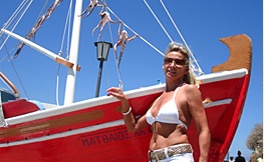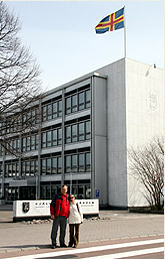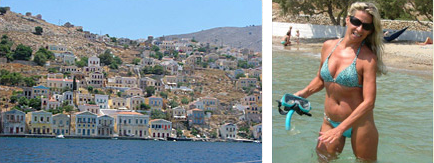Since a few years ago, holidays under full sail have been our favourite form of family summer tourism. We have taken a special liking to the islands around Greece. In the year 2003, we sailed around the islands of the Ionian Sea, in 2004 - the North Sporades on the Aegean Sea, and in 2005 - the Cyclades on the Cretan Sea. In the course of those voyages, we have sailed around circa as many as twenty five Greek islands and called in at over fifty ports. Such holidays are a wonderful form of getting to know new places, contact with nature, and an opportunity to meet some unusual people.
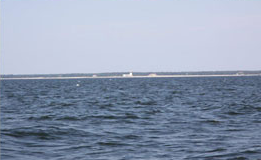
THE BAY OF PUCK AND THE LAKE GENEVA
This year, we decided to sail around a very exceptional place, which some call the Small Polish Sea.
The Bay of Puck, which I am talking about, is a place valued by sailors as well as other enthusiasts of water sports. We simply decided to take a trip down memory lane. Our yacht, SY „Sztorman” HOH Puck, turned out to fit such a purpose perfectly, and despite its age, it proved to be quite seaworthy and sturdy. We sailed from Puck to Jastarnia and further to Gdynia. The weather and winds were really good. At the same time, it is also worth mentioning the development of this region, which is so visible at every turn. I think that many enthusiasts of water sports value the charms of this place and they moor their boats in the Bay of Puck more and more often. It was so nice to reminisce.
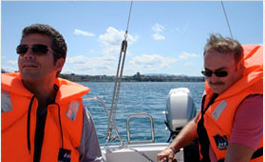
In Switzerland, Lake Geneva is said to be the most sky-blue lake in that country. It may well be true. So far, I have had opportunities to see Lake Geneva from the land and air. This time, owing to the corporate social program, I could discover that lake from the sailor’s point of view – and quite seriously indeed, as a sailing regatta was organized for us on that lake. One can say the lake is just as any other lake, only big – like Śniardwy or Mamry lakes; however, it is not really so.
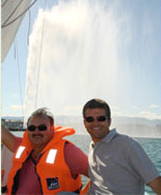
Lake Geneva, sky-blue though it may be, presents specific and rather challenging sailing conditions, including changeable winds blowing down from the Alps – very turbulent squalls. Nevertheless, it has its sport charm, particularly at the time of a regatta. A separate special attraction of the lake is its fountain - situated in the bay nearly cutting into the very centre of Geneva – which is gushing into the sky to the height of nearly 50 meters. The well-informed say each second as much as 40 tons of water is up in the air. It is a real challenge to sail up as close to the fountain as possible and not allow it to capsize the boat. The mass of water gushed by the fountain’s powerful pumps causes very strong air turbulence. Yet, we were lucky enough not to be capsized!
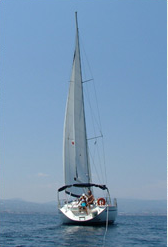
THE GULF OF CORINTH AND THE IONIAN SEA
This years' holiday brough yet another maritime adventure which took place in the Gulf of Corinth among the isles of the south Ionian Sea. This time the wind blew in the sails of a Bavaria 46 -type sailing boat, whose name was TRAMONTANA II.
In order to reach the Gulf, we had to sail the Corinth Canal. Its broad fame derives not only from historical importance - it was here that ancient Greeks had to roll their boats on logs to cross the Isthmus before sailing further - but also from the world's highest charge for crossing (142 EUR).
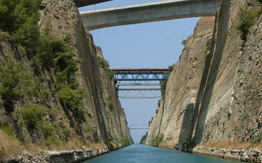
Our first stop was at New Corinth - a city built in 1928 after the tragic earthquake which completely destroyed the old city. Here, we met Mr Giannis Xalimourados, the owner of an excellent fish tavern. The food may not have been cheap, but the charm and grace of the owner as well as tasty dishes were truly worth the pay.
From there, we sailed further to Paralia, Itea, Trizonia, Patras, Zakynthos, Kefalonia and Levkas. Trizonia - an island and at the same time a port town - although flat, enchanted us with its lush green landscape. Leaving it, we were taken by surprise by a Greek F16 pilot, who flew less than 30 meters above us. To apologise for his poor joke, he flapped the wings of his plane.
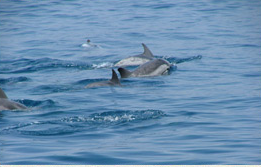
We were also very lucky, as during our cruise, we came, quite unexpectedly, across a shoal of dolphins - we counted about 40 of them.
On Zakynthos we visited the KOMIS tavern, where exquisite traditional Greek cuisine is served. Unfortunately, during our adventure, we were not spared from a storm, which prevented us from visiting the port of Frikes. Maybe some other time.
All in all, the most beautiful place we had a chance to visit during this cruise was the isle of Levkas with the port of Sivota. Interesting buildings, exquisite restaurants, marvellous views - this place will stay in our memories forever.
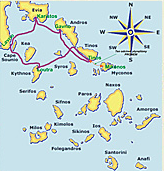
THE EASTERN SPORADES
In 2007, we were planning to reach the Eastern Sporades archipelago, but the weather thwarted our plans.This time we set out from Lavrio (continental Greece), a port near the Temple of Poseidon, and our first stop was in Karistos, on the isle of Evia. The plan was to sail to the isle of Hios, unfortunately, even though it was sunny, gusty wind of Beaufort scale 6-7 successfully prevented us from sailing any further East. Instead, we managed to reach port Garvio on Andros, where we were greeted by a worrying sight of a number of yachts with torn sails.
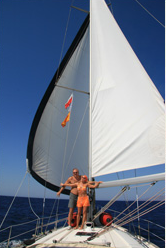
Our only chance to visit other islands was to take a large ferry (no excursion boats left the harbour) to the isle of Mikonos. After whole six days, the weather improved for a while and allowed us to sail towards Kithnos. On our way there, however, it changed again, the wind reaching a regular 8. We were forced to reduce the sails as much as possible and strive to find some space in the harbour, already full of other vessels. This turned out to be our last stop - from there, we set off at the break of dawn back to Lavrio. Later the same day, the weather deteriorated again.
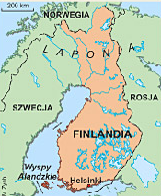
ALAND ISLANDS
Aland Islands - form an archipelago consisting of over 6'500 islands and islets situated on the Baltic Sea, at an entrance to the Bothnic Gulf. The Aland Islands are inhabited by 26'967 people (as of 31.03.2007). It is an ethnically Swedish territory, however, formally within the administrative borders of Finland. The Aland Islands' capital is Mariehamn (Maarianhamina in Finnish). This ten-thousand town is situated 590 km north of Cape Rozewie, 870 km from Warsaw, slightly above Stockholm, and nearly exactly at a latitude of Helsinki. We went to those islands in May 2007, and were lucky to have good weather there, as you can see on the photographs.
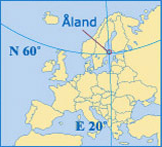
Islands of Peace - the Alands are called Peace Islands (Fredens öar). A ban on carrying out any military exercises, flights of military planes, and sailing of any navy ships into the internal waters - is binding there. Inhabitants who are born on those islands, or who have come there below the age of twelve - are exempt from the obligation of military service.
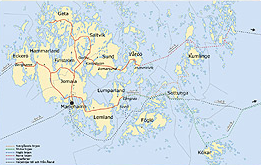
Autonomy - the Aland Islands have got autonomy except for the spheres which are managed centrally by the Finnish state i.e. foreign policy, law and judiciary, trade, and finances. In the issues related to international agreements concerning the Aland Islands, a consent is needed of their representatives, and it was the case before
Finland and the Alands acceded to the European Union, among others.
Language - the official language is Swedish, which is used by 94% of inhabitants.

Flag - since 1954, the Aland Islands vaunt their own flag. It is the Swedish yellow cross against blue background with another smaller red cross inscribed within that bigger one. On the photograph beside, I and my wife Grażyna standing in front of the Aland Parliament building with the Aland flag fluttering on its top..
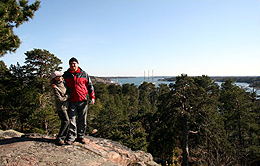
Paradise on earth - the Aland Islands are an oasis of quietness. Its thickly tree-covered red rocks are cutting into the sea. The views are picturesque, which you can see on the photographs. The Aland Islands can easily be explored riding a bike. It is a very popular means of transport, and not only among tourists. Finnish people very much enjoy visiting the Aland Islands, and one the reasons is the fact that prohibition is not binding on them. One can enjoy eating there tasty and original meals. The local specialities include fish dishes prepared in various ways e.g. corned, smoked, or roasted, as well as the lamb ones whose unique taste and aroma are due to meadows full of herbs on which sheep are pastured.
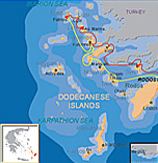
DODECANESE ISLANDS
In July 2006, onboard a yacht named "Tilos" of the Dufour GibSea 41 type, from the marina of Mandrakes on Rhodes, we set off to reach the Dodecanese archipelago in the Aegean Sea. We visited the islands of Simi, Kos, Kalimnos, Leros, Lipsi, Patmos, again Kalimnos and Kos (the harbour of Kamri) and Tilos, to come back to the island of Rhodes. In total, we sailed 297 nautical miles. During this voyage, I explored another group of Greek islands. The northern part of the Dodecanese archipelago is the most attractive one of all the Greek islands which I have so far managed to see - altogether 33 islands. Not too many tourists are seen there. One can even say that these islands still remain virgin.
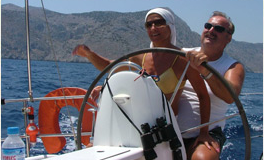
I was particularly enchanted by the island of Lipsi. Also greatly impressed was I on the island of Patmos by the monuments dating back to the beginning of Christianity and connected with the activities of Saint John the Apostle. The island of Nisyros is also worth visiting, which is a volcanic one, and the volcano situated in its centre, with the craters of Alexandros and Stephanos, is in fact the greatest tourist attraction of this island. It is inhabited by 900 people, and despite its rather small surface area (40 sq. km) it has a few worth seeing objects, including the Palekastro castle being as many as 2600 years old. Among other monuments, there are numerous monasteries of which the most interesting one is the Panagia Spiliani that had been built within the walls of castle belonging to the Knights of the Order of St John of Jerusalem.
During our voyage, the force of wind was reaching eight degrees on the Beaufort scale. In July, the meltemi blows with a considerable force, allowing to sail effectively, but at the same time requiring substantial skills of the crew.




